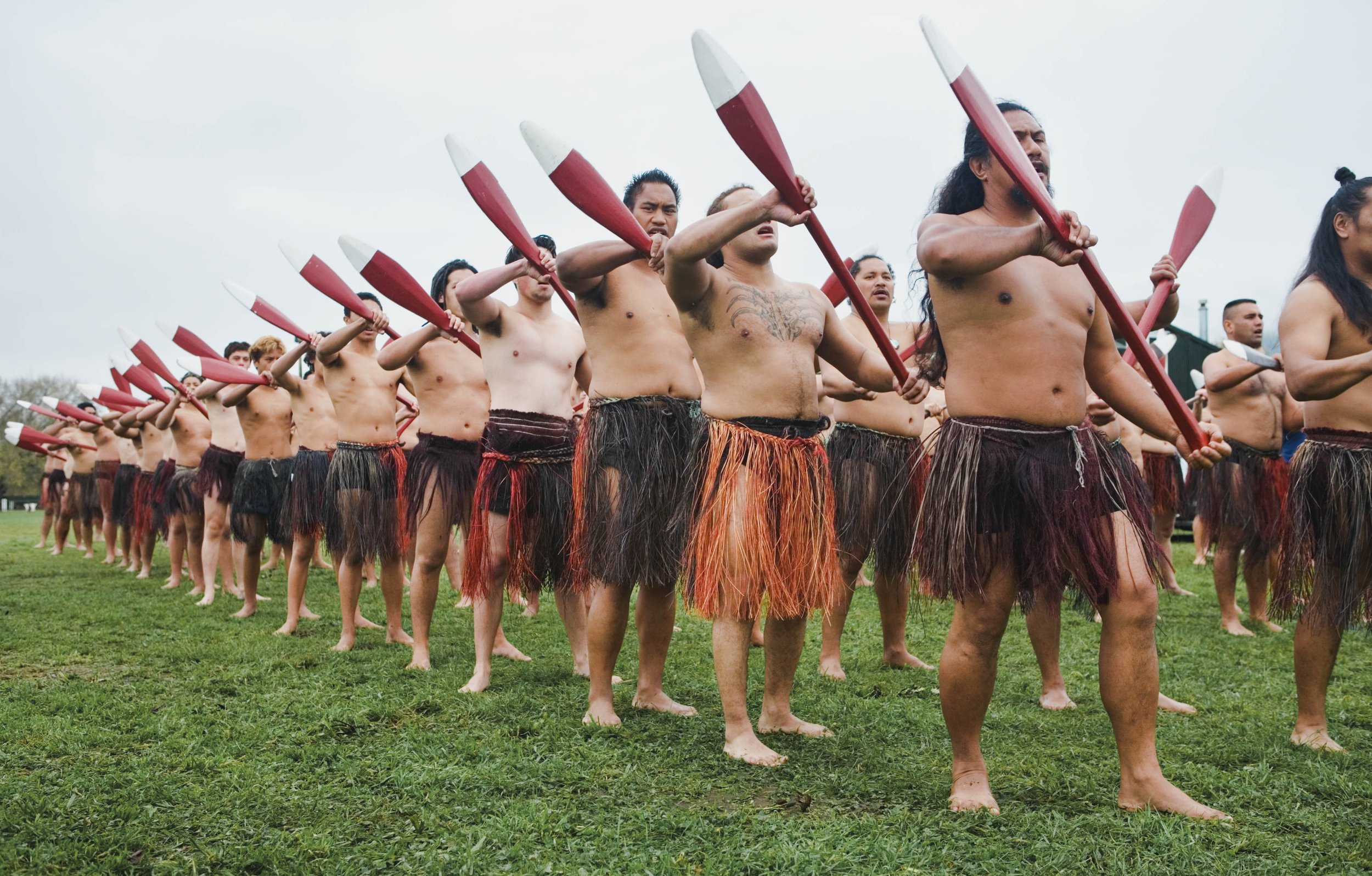TE REO MĀORI: From Suppression to Celebration
LINGUAFILES
By Alice Pol
Published July, 2024
This article will soon be available in German, Japanese, Spanish, Italian.
Te reo Māori has been in contact with English for less than 200 years but has been spoken in Aotearoa (New Zealand) for centuries. How did a language in decline become a central part of Aotearoa's national identity?
Māori men during a ceremonial dance. (Photo by Jorge Royan, 2006)
TE REO MĀORI
Name of the language in English: Māori
Native Name: Te reo Māori, often called “te reo” in Aotearoa.
Location: Aotearoa (New Zealand)
Family: Austronesian
Related Languages: Cook Islands Māori, Tahitian, Moriori. It is more distantly related to Tongan and Samoan.
Number of Speakers: According to the 2018 New Zealand Census, 185,955 people can converse in te reo. As of 2021, a quarter of Māori speak te reo as their first language.
Official Status: The official language of Aotearoa since 1987. New Zealand Sign Language (NZSL) is also an official language of New Zealand, however, English is not. In 2018 and 2023, the New Zealand government moved towards making English official, which would threaten the use of te reo and impact attitudes towards it. There hasn’t been any further movement towards this goal as of May 2024.
UNESCO Classification: Definitely Endangered (DE)
Writing System: Latin Alphabet
THE TE REO RENAISSANCE
Te reo has regional varieties that most speakers can understand. Some sources list only a Northern and Southern variety while others list up to five in the North Island. A handful of sound changes and some vocabulary are the primary differences between these varieties. However, particles, short words that indicate grammatical components in a sentence, also vary. One such sound variation is the differing pronunciation of /n/, /k/, and /ng/. For example, most te reo speakers say, /anga/ for “shellfish”, but in the Bay of Plenty (East North Island) they say, /ana/, and in the South Island they say, /aka/.
Te reo Māori has been in contact with English since the mid-1800s. In under 200 years, it has experienced significant decline and revitalisation. This was particularly noticed in the 1900s when many Māori became bilingual, using te reo at home and English at work and school. In education, students were punished for using their language. After World War II, many Māori moved to cities and used even more English. English became associated with success and speakers used less te reo.
Māori women during a Waitangi Day celebration in 2009. (Photo by Daniel Pietzsch.)
Later, in the 1970s and 1980s, the Māori Renaissance occurred, a resurgence in Māori culture and commitment to biculturalism in Aotearoa. It led to legislation supporting te reo Māori and establishing a range of revitalisation initiatives including Kōhanga Reo, “language nests”. Kōhanga are language immersion preschools, initially run by the community. Many view them as a cornerstone to Aotearoa's revitalisation strategy and they continue to thrive today with the original cohort’s children now attending.
“Ka ngaro te reo, ka ngaro tāua, pērā i te ngaro o te moa.”
If the language is lost, man will be lost too, as dead as the moa.
After te reo Māori became an official language, a decades-long effort led to the language becoming ubiquitous throughout Aotearoa. Its vocabulary has penetrated New Zealand English. It is increasingly common to hear the language spoken around schools (English- and Māori-medium), workplaces, and on regular shopping trips.
Māori men during a ceremonial dance. (Jorge Royan, 2006)
Institutional support for te reo Māori is huge, with Te Taura Whiri i Te Reo Māori, or the Maori Language Commission, leading the way in te reo Māori revitalisation policy. For New Zealand citizens and permanent residents, beginner and intermediate-level te reo courses are free and many workplaces encourage and support their employees to learn the language. Te Wiki o te Reo Māori (Māori language week) is an annual awareness campaign for the language. A huge range of initiatives have been created for the occasion. Whittaker’s, a chocolate brand, renamed their chocolates in te reo. Musicians such as Lorde participated in the Waiata/Anthems project where she translated (with professional translators) and recorded some of her songs in te reo Māori. Matewa Media has dubbed four Disney films, including Moana, in te reo Māori, with more in progress. These films are available to watch on Disney+.
While there is still a way to go before the language is stable, how Aotearoa has embraced te reo Māori leaves many Kiwis cautiously optimistic.
(Steve Evans, 2011)
Edited by
Aline Vitaly, Perla Camacho-Cedillo & Marvin Nauendorff
Cite This Article
Pol, Alice. 2024. "Te Reo Māori: From Suppression to Celebration." Linguaphile Magazine. July. https://www.linguaphilemagazine.org/editorial/linguafiles-te-reo-maori.
Further Reading
Airana Ngarewa, "Making te reo Māori official", The Spinoff
Airana Ngarewa, "The government banned te reo in the past. It won’t succeed again", The Spinoff
Bibliography
Derby, Mark. "Māori–Pākehā relations - Māori renaissance." Te Ara - the Encyclopedia of New Zealand. Accessed May 14, 2024. http://www.TeAra.govt.nz/en/maori-pakeha-relations/page-6.
Harlow, Ray. 2006. Māori: A Linguistic Introduction. New York: Cambridge Press.
Higgins, Rawinia, and Basil Keane. "Te reo Māori – the Māori language - The Māori language." Te Ara - the Encyclopedia of New Zealand. Accessed May 13, 2024. http://www.TeAra.govt.nz/en/te-reo-maori-the-maori-language/page-1.
Kenny, Katie. 2023. "NZ's Official Languages: What You Need to Know." RNZ News, December 14. Accessed May 27, 2024. https://www.rnz.co.nz/news/what-you-need-to-know/504722/nz-s-official-languages-what-you-need-to-know.
Stats NZ. 2023. "Te Reo Māori Proficiency and Support Continues to Grow." Stats NZ, May 27. https://www.stats.govt.nz/news/te-reo-maori-proficiency-and-support-continues-to-grow/.
Te Kōhanga Reo National Trust. "Mō Mātau." Te Kōhanga Reo. Accessed May 14, 2024. https://www.kohanga.ac.nz/kaupapa/moo-matau.
Te Mātāwai. 2021. Māori Language Dialect and Regional Iwi Variation: A Literature Review. Waikato-Tainui College of Research and Development. https://www.tematawai.maori.nz/assets/Research-Reports/Literature-Review-Maaori-Language-Dialect-and-regiona-iwi-variation.pdf.
Te Wānanga o Raukawa. "Free Online Te Reo Courses Starting Feb and July Each Year." Te Wānanga o Raukawa. Accessed May 14, 2024. https://www.wananga.com/news/learn_te_reo.
UNESCO. "Māori." World Atlas of Languages. Accessed May 13, 2024. https://en.wal.unesco.org/languages/maori.
Waitangi Tribunal. 1986. Report on the Te Reo Maori Claim (Wai 11). Wellington: Waitangi Tribunal. https://forms.justice.govt.nz/search/Documents/WT/wt_DOC_68482156/Report%20on%20the%20Te%20Reo%20Maori%20Claim%20W.pdf.




